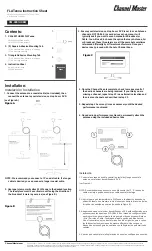
5 / 10
Offset Parabolic Antennas
Aligning the Antenna
The antenna must be exactly aligned towards the satellite in
respect of both the direction (azimuth) and also the inclination
(elevation). For multi-feed applications, the antenna should be
aligned towards the satellite which is transmitting the weakest
signal.
Setting the Inclination (Elevation)
1. When adjusting the inclination (elevation), observe the
scaling on the right side of the mast fixing, as seen from
behind (arrow
①
in Fig. 7).
2. Loosen both screws on each side of the mast fixing to
modify the elevation of the antenna (
②, ③ in
Fig. 7).
3. Adjust the inclination (elevation) in accordance with the
arrow.
Tip
You will find the exact elevation angle for your
location in the azimuth/elevation table at the
end of this manual. If your location is not listed
in this table, use the nearest listed location as
your reference.
4. Hand-tighten the two screws on the mast fixing. Fine adjust-
ment of the elevation must be carried out later, see
Fine
Adjustment, p. 6
.
Setting the Direction (Azimuth)
Tip
If you yourself are unable whilst performing the
adjustments to read the results of the alignment
work on an antenna meter or screen connected to
the satellite receiver, you may need an assistant for
the following steps. The precise alignment of the
antenna can be achieved only if a digital antenna
meter is used. Ask your dealer about this.
1. Set the satellite receiver to a known channel so that you can
check that you have really "locked on" to the desired satel-
lite.
2. Slightly loosen the wing nuts on the mast clip (
①
,
②
in Fig. 8).
3. Twist the antenna so that it faces roughly south.
4. Slowly twist the antenna about its central axis to the left and
right until the best reception is obtained for the selected
channel.
5. Tighten the wing nuts just enough to prevent the antenna
turning.
1
3
2
Fig. 7:
Setting the inclination (elevation)
1
2
Fig. 8:
Setting the direction (azimuth)






































